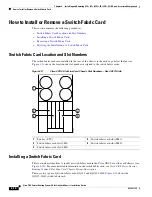
4-29
Cisco CRS Carrier Routing System 4-Slot Line Card Chassis Installation Guide
OL-10971-10
Chapter 4 Installing and Removing SFCs, RPs, MSCs, FPs, LSPs, PLIMs, and Associated Components
How to Install or Remove a Route Processor Card
Step 10
To fully seat the card in the midplane connector, grasp both card ejector levers simultaneously, then push
them both inward until they are flush against the front edge of the card carrier. After the guide pins make
contact, continue pushing the card carrier until the card ejector levers begin pivoting forward.
Caution
Verify that the openings on the card ejector cams pass over the tabs; otherwise, one or both ejector levers
may bind when you attempt to close the levers, thereby damaging or breaking one or both.
Step 11
To seat the card firmly in the slot, use the screwdriver to tighten the captive screws.
Note
To comply with the Telcordia GR-1089 NEBS standard for electromagnetic compatibility and
safety, connect the Ethernet interfaces only to intrabuilding or nonexposed wiring or cabling.
The intrabuilding cable must be shielded and the shielding must be grounded at both ends.
What to Do Next
After performing this task:
•
Place the impedance carrier in an antistatic bag for storage and future use.
•
Verify that the card has been installed properly (see the
“Verifying the Installation of an RP or PRP
Card” section on page 4-30
).
•
Connect the console port and LAN port. For more information, see the latest release of the
Cisco
IOS XR Getting Started Guide
on www.cisco.com.
•
If you are performing the initial installation of the system, install the MSCs (see the
“Installing an
MSC, FP, or LSP” section on page 4-33
).
Removing an RP or PRP Card
This section describes how to remove a route processor (RP) or performance route processor (PRP) card
from the chassis. For more detailed information on the route processor card, see
Cisco CRS Series
Carrier Routing System 4-Slot Line Card Chassis System Description
.
Every Cisco CRS 4-slot line card chassis contains two route processor cards in dedicated slots on the
front (PLIM) side of the chassis (see
Figure 4-17
).
Prerequisites
Because chassis operation may be impacted by the removal of an RP card, perform these tasks only if
one of the following conditions exists:
•
When you are certain that the second RP in the chassis is operational and, if not already the active
RP, ready to assume control (this happens automatically).
•
When the chassis is undergoing scheduled maintenance.
•
When the Cisco CRS 4-slot line card chassis is powered down.
Failure to follow these guidelines can result in interruptions in data communications and network
connectivity.










































